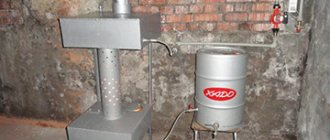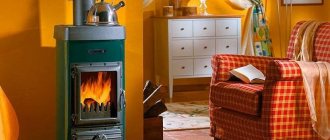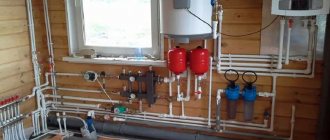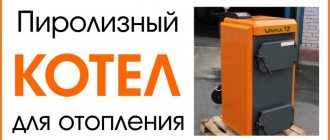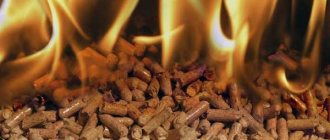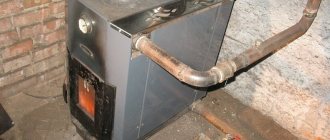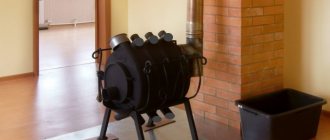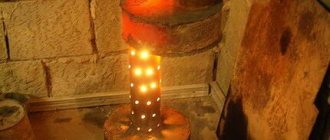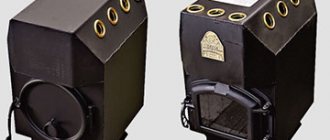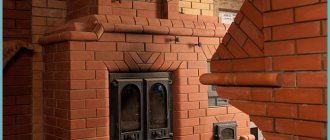Heating utility rooms, service stations, greenhouses and workshops is a pressing problem for many.
Boiler under development
It is not always possible to gasify these premises, and heating with electric appliances is very ineffective. An exhaust boiler with a water circuit is an excellent solution that allows you to use resources economically and efficiently.
In this article we will look at the principle of operation, the design of the boiler during testing and tell you how to build this unit with your own hands.
The main advantage of such a boiler is its fuel efficiency, because sometimes you can even get it for free. Many car services and workshops provide recycled oil on condition of pickup.
Principle of operation
The principle of boilers operating on recycled fuel is the same in all cases. It consists of evaporating the oil and burning the steam from it.
Principle of oil evaporation
But there are small nuances in this technology. All used oils contain many heavy metals, additives and other elements. The task is to build a unit that will allow you to accumulate heat inside, and not immediately discharge all these elements into the chimney. Complete oxidation of all elements occurs only if the maximum temperature inside the boiler is reached - 6000C.
The temperature indicator in this case is a very important point. Without going into lengthy explanations of chemical processes, we can say briefly: harmless combustion and evaporation of fuel can only occur at a temperature of 600 degrees. A deviation of 200 degrees to one side or the other will provoke the release of very harmful toxic substances.
Exhaust boiler with water circuit
A homemade boiler in operation looks like this: two metal containers are connected to each other by a pipe and at the same time they are at different heights. The upper tank is equipped with a smoke exhaust pipe, the length of which must be at least one meter.
Used oil is poured into the lower tank. The top layer of oil in the evaporation chamber heats up, resulting in the formation of steam. As it rises, it exits into a perforated pipe and connects with air, reaches the upper tank and burns. And the combustion products themselves are discharged through the pipe through the chimney.
Thus, the room is heated, but no toxic waste is released that is harmful to human health. This fact immediately answers the main question that interests many before building such a unit: “How harmful is a boiler during mining?”
Waste oil boiler diagram
With proper design and compliance with all necessary technical aspects, a waste fuel boiler does not pose a threat to human health. But here you need to strictly adhere to the operating conditions and understand that this unit is suitable for heating only utility rooms. Such a device cannot be used to heat a house. After all, it uses spent fuel, which is difficult to classify as a pure type of fuel.
You should clearly understand the operating principle and technology of oil evaporation in such a unit. It is not the oil itself that burns here, but its vapor. Due to the fact that the spent fuel heats up and begins to evaporate even before combustion begins, it becomes possible to decompose such burning fuel into lighter elements.
Where are such heating units used?
- in production premises;
- in premises for keeping animals;
- in auto repair shops, service stations;
- in greenhouses;
- in warehouses and garages.
Almost any oil, including shock-absorbing oil, can be used as fuel for such a boiler.
Operating rules
When using a heating boiler that runs on waste oil, certain rules must be followed. Otherwise, gas pollution in the room or even a fire may occur.
The basic rules for using the boiler are as follows:
- A working device must not be left unattended;;
- When the boiler is on. You cannot add fuel to it;
- In a boiler of this design, only waste oil can be burned. it is not suitable for using other types of fuel;
- You need to make sure that no water gets on the surface of the hot boiler. otherwise, due to sudden cooling, it may simply burst;
- When the boiler is running, the burner hole must always be open;
- It is strictly prohibited to keep combustible and flammable substances near the boiler;
- When the boiler is on, the damper is not closed. otherwise all the carbon monoxide will go into the room.
When the boiler is running, the burner hole must always be open
Technology of oil evaporation in a boiler during production
Fuel combustion and oil evaporation can occur in two ways:
- Igniting a liquid substance. In this case, steam will be released, which will burn out in a special chamber.
- Pouring liquid onto a hot surface, resulting in the formation of steam.
One of the simplest ways to implement this technology is to use a hot metal bowl, onto the surface of which waste oil drips.
The principle of drip fuel supply
The bottom line is that upon contact with hot metal, the fuel abruptly evaporates rather than heats up. Diffusion of steam occurs with air, which is supplied to the tank. The vapors flash and burn, resulting in heat.
In order to achieve maximum efficiency of such a unit, it is necessary to ensure that the burning mixture remains in the combustion chamber for a long time. To do this, install a stationary impeller at the mouth of the chimney, which will help create the necessary turbulence in the combustion chamber.
A homemade boiler without a water circuit can heat a fairly large area. Its power is enough to heat a small workshop of 30-40 square meters, a greenhouse or a garage.
If it is necessary to provide heating for large rooms, then a boiler with a water circuit should be installed. At the same time, fuel consumption is striking in its efficiency: from 0.5 liters to 1 liter per hour.
Depending on the needs and desires of the owners of utility premises, such a home-made unit can be equipped with one or two circuits. If the task comes down solely to heating the room, then one circuit will be sufficient.
If you need to heat water for domestic purposes, then you need to make two circuits. For these purposes, a heat exchanger is installed in the upper tank.
Despite the excellent efficiency, versatility of fuel use and greater efficiency, this operating principle is rarely implemented on foreign boilers. But domestic manufacturers often produce units that are widely used for economic purposes.
The most difficult thing in independently performing such a design is the method of preheating the bowl onto which the oil is dripping. Those who make such a cauldron with their own hands do it simply: they throw a wick soaked in gasoline into the tank and set it on fire. Once the bowl is heated to the desired temperature, simply turn on the oil supply.
Boiler under development
The second point that you need to pay attention to is the uniform drip supply of oil. It is necessary to ensure an optimal level of spent fuel filtration.
To do this, just put a car oil filter on one end of the tube, which is lowered into the spent fuel tank. The filter must be changed at least once a month. If the fuel is dirty, then more often.
Another problem can be the fuel pump, which must supply the right amount of oil to the tank. By assembling a structure from fittings, a nipple and two tees, you can achieve “protection” from fuel overflow. The hose will contain a portion of oil that is placed in this unit.
Pump
The rest will simply flow back into the tank. The factory design of the boiler with automatic overflow protection is carried out according to a similar scheme.
Another idea for drip fuel delivery is to use a piece of a regular medical drip. This fragment is put on the lower fitting, and the frequency of drops is determined using the regulator wheel.
The amount of fuel that drips onto the bowl should be just enough so that it burns evenly, but does not smoke. If the fuel changes, the drop frequency must be adjusted again each time.
A good modern boiler for testing must be equipped with protection against oil boiling and fuel overflow. To avoid a fire, you need to ensure that the oil level in the reservoir is lower than in the stove itself.
In order to make a boiler with a water circuit, it is enough to arrange a water jacket around the furnace body. This circuit can then be used at your own discretion: either to heat a large room or to heat water.
In order to connect the pipes leading to the heating system to the tank, you will need a pump to circulate water.
The boiler during testing seems to be good for everyone: it is both economical and easy to operate. But how to ensure that it maintains combustion for a long time?
A way to prolong the combustion
You cannot add oil while it is operating - it is dangerous. Waiting for complete combustion is inconvenient. You can, of course, make a large fuel reservoir, but then a large amount of oil will not have time to heat up to the required temperature.
An additional tank will help solve this problem, where the main fuel supply will be filled. It will be connected to the lower body according to the principle of communicating vessels.
What should the chimney be like?
The main requirement is serviceability. The system for removing thermal gases that are formed as a result of combustion must be as reliable as possible, and preferably not whimsical.
Main characteristics of the chimney:
- Low thermal conductivity of the materials from which it is made.
- The protrusion from the roof is at least 0.5 meters.
- Arrangement of thermal insulation in places of contact with wooden floors.
- The volume of the chimney must correspond to the amount of gases emitted by one or another heating device.
Don't neglect safety for the sake of the beauty and design of your home or any other building.
Advantages and disadvantages of a boiler during development
Like any heating unit, an exhaust boiler has its advantages and disadvantages. Before you decide to do it yourself, we suggest you familiarize yourself with this list in detail.
Advantages:
- low cost of resources;
- simple design and clear operating principle of the boiler;
- the ability to use a boiler to heat water (when constructing a water circuit);
- rapid heating of liquid;
- possibility of making it yourself;
- compactness;
- high efficiency.
The relative environmental safety of such a boiler can be considered more of an advantage, but it should be emphasized that this safety is achieved only with strict adherence to all technical nuances during construction and operation.
DIY boiler
The “output” boiler produces a temperature of 95 degrees, which allows you to properly heat a garage, greenhouse, or workshop even in the most severe frost.
You can provide a small hob on the structure, with which you can easily heat a kettle or heat up lunch.
Flaws:
- the need for regular cleaning;
- lack of support for this unit at the legislative level;
- unpresentable appearance.
As you can see, this heating design has many more advantages than disadvantages. Therefore, if you decide to build an exhaust boiler with a water circuit yourself, we offer you step-by-step instructions that even a beginner can handle.
Types of chimneys
There are a large number of types of chimneys. But the most popular, at the moment, are only three types:
- brick
- modular single circuit
- modular dual-circuit
Brick chimney (made of brick)
Advantages : fire safety, high reliability. Disadvantages : unevenness inside the pipe delays the passage of smoke. Water and sulfur oxide react, resulting in the formation of sulfuric acid, which over time destroys the structure.
Modular single-circuit chimneys (made of stainless steel pipes 0.6-1 mm) Advantage : lower price, ease of repair, low weight. Disadvantages : formation of a large amount of condensate, service life no more than 10-15 years
Modular two-tone chimneys (2 pipes with non-flammable insulation between them) Advantages : high throughput, minimal amount of condensate. Disadvantages : the price is significantly higher than that of single-circuit
Fire safety measures
It should be understood that such a home-made structure must be made strictly in accordance with established fire safety standards.
To protect the premises from fire, we also recommend adhering to the following rules:
- The chimney diameter must be at least 100 mm. Ideally, use sandwich pipes, on the surface of which a minimum amount of soot is formed.
- It is prohibited to store flammable items (fuel tanks) in the immediate vicinity of the tanks.
- All joints must be sealed.
- The thickness of the walls of the tanks where fuel combustion occurs must be at least 4 mm.
- To ensure the flow of fresh air into the room and to avoid smoke, it is necessary to equip the boiler room with a forced circulation system. The air exchange rate per 1 cubic meter of area is 180 m3/hour.
Installation Tips
Installing a boiler that uses waste oil is practically no different from installing other types of heaters. There is one advantage: thanks to the presence of turbocharging and smokeless combustion of liquid fuel, the chimney does not have to be raised by 6-7 meters. It is enough to remove the chimney head from the wind pressure zone and raise it to a height of 4 m.
Regarding proper installation, we will give the following recommendations:
- The boiler and steel chimneys not protected by insulation are located at a distance of 0.5 m from combustible walls and other elements of a wooden house. The minimum distance from fireproof structures is 100 mm.
- Pass through the outer wall and the entire outer section of the flue with an insulated pipe - a sandwich, otherwise there will be a lot of condensation and soot. The chimney installation technology is described in detail in a separate material.
- Be sure to install a safety group on the heating supply line.
- Organize a good exhaust hood in the furnace to remove odors. Combustion air intake can be provided from the street.
- Equip the supercharger with a speed regulator and the oil line with a valve. This will allow you to control the power of the heat generator manually. Do not confuse the control valve with a regular tap; shut-off valves are installed on pipelines in any case.
- Make a primitive automatic emergency stop - install a thermostat on the supply, turn off the fan and the oil pump in case of overheating of the coolant.
How to weld a simple stove
Then the heat is released in greater quantities into the room, rather than being “thrown out” to the street.
Another upgrade is to make an iron drawer. Oil is poured into it. With this design, the stove is easier to maintain. The drawing contains all the necessary dimensions. Before assembling a homemade oil stove, it is necessary to select the correct diameter of the firebox and body. Here everything depends on the volume of the room that needs to be heated. If it is a garage of 3 by 6 meters, take a profile of 80x80x4 mm. The fuel box is made of metal 60x60x4. It is more difficult to work with round rolled metal.
The step-by-step instructions look like this:
- Cut the metal according to the drawings to make a casing, drawer, afterburner. If the latter has a bend, the tube is cut at an angle of 45 degrees.
- For a profile of a smaller standard size, one wall is cut out with a grinder. Plugs are welded to the sides. The result is an open container to which you need to attach a handle.
- The structure is welded. It is necessary to drill an air hole at the top of the fuel chamber. The pipe is perforated. At this point the work is completed.
It should be taken into account that you need to calculate the number and diameter of holes in the afterburner. If you use a profile of 80 by 80 mm, then the cross-sectional area will be equal to 6400 square millimeters. This value is divided in two
Pay attention to the markings of the drill used. If it is 8 mm, then the hole area will be 50 sq. mm
Now 3200 must be divided by 50. The result is that 64 holes will be required to work effectively. However, as a result of customization, their number can be increased.
It is important that the chimney is of sufficient length. The elevation of the chimney outlet must be at least 5 meters
Then the operation of the stove during testing will ensure the highest possible efficiency even without supercharging. Otherwise, the pipe will have to be extended to this mark. But you can further increase productivity if you organize an inclined chimney running along the wall. The heated metal will release heat into the room. Only in this case is it important to follow fire safety rules. There should be no wooden shelves above the pipe, and no wallpaper on the walls. Even better is to cover the wall with a metal sheet.
Making a drip heater
Professionals who have assembled more than one “dripper” use old propane cylinders with a diameter of 200 mm. Oxygen ones are also suitable, since their cross section is 220 mm. the latter benefit due to thick walls. They serve for a long time, do not burn out, and accumulate heat. Pipe C-10 is also suitable if it has a wall thickness of 5 mm. An excellent option for a durable housing is pipes made of heat-resistant stainless steel alloys, alloyed chromium, molybdenum or nickel (for example, 15X1MF or 12X18H12T) with a wall no more than 3 mm. However, it is not advisable to specifically purchase this raw material due to its high cost.
Technologically, the manufacturing process is as follows:
- A flame bowl is made using a piece of pipe or ready-made steel containers. This one is pulled out through a rubber hatch, so it is not made too big.
- The openings necessary for connecting the chimney pipe and the cleaning service hatch are cut out in the body. The latter is framed and closed with a door. Bolts can be used for fastening.
- An afterburner is being made. All holes are not made at once. Usually the bottom 2-3 rows are drilled, and the rest are drilled during the setup process. If you do everything at once and there are too many of them, you will have to make a new one.
- Weld the cover with the air duct and flange. The latter is necessary for installing the fan. The fuel supply device is connected. Photo and video instructions will help here.
Now assemble all the components and connect the electrical wiring. The structure will be more stable if you make a metal frame. A heavy metal profile is suitable for this.
What is used oil?
Refining is an oil-based product that is obtained during long-term operation of a car engine. Under the influence of external factors, the oil loses its normal characteristics and becomes unsuitable for further use. The mass of the product contains a whole complex of various particles formed during the operation of metal parts of mechanisms.
The used oil must be drained and replaced with new oil. When replacing, it is recommended to dispose of the waste at special collection points, where it finds its useful use in the form of fuel for heating the room.
Assembling a homemade heating device
The boiler can be made in various shapes depending on the wishes of the owner. As a rule, it is made round and rectangular.
In order to begin assembly, you should prepare the necessary materials and tools for the work. Their standard list looks like this:
- steel sheets whose thickness is more than 4 mm;
- air duct pipe;
- pieces of reinforcement (4 pcs.);
- pump and compressor;
- expansion tank;
- welding tools;
- asbestos sheet.
Since the boiler can be of different configurations, instead of the main material, you can use improvised means, for example, a cylinder or a thick-walled pipe of sufficiently large diameter.
Manufacturing of the boiler body
To assemble the boiler body, you first need to take a pipe of the largest diameter and cut it on both sides to obtain a cylinder, the length of which should be no more than 1 m. The same cylindrical shape is made from a pipe of a smaller cross-section, but 20 cm high.
After that, holes are cut out in the plates, in which the diameter of one should be equal to 20 cm, and the second - in accordance with the dimensions of the chimney. Then a cylinder of larger diameter is welded on both sides with pre-prepared plates so that a 20-centimeter hole is made from the bottom.
A cylinder of smaller diameter is built into it and welded. The bottom of the pipe should also be covered with a plate and fixed by welding. Then reinforcement legs are attached to the body, and ventilation holes are also drilled. After that, a chimney is installed on top of the cylindrical device, and a door is cut out in the lower part using a grinder.
This housing has the simplest configuration, but even a water circuit can be connected to it. To do this, a fuel supply container, a pump and an air compressor are additionally connected. At the same time, a circuit is also drawn to ensure water circulation.
Burner installation
To ensure uniform heating of the water in the boiler for a device with a dual-circuit system, it is necessary to install a reliable burner.
A ready-made burner can be purchased in a store or ordered from a specialist, but you can also make it yourself using a specific scheme.
Preparing the site for installing the system and exhausting the chimney
The assembled parts of a heating device operating during mining are usually installed in the corner of the building. Since the boiler heats up very quickly, the floor and walls should be prepared for this.
In the place where the system will stand, it is necessary to make a concrete screed or cover it with ceramic tiles. The walls adjacent to the device should not be made of flammable materials.
After the housing of the heating system is fixed in the selected location, it is necessary to begin installing the chimney. As a rule, it is made at least 4 m long.
In the section of the ceiling covering where the pipe goes outside, a heat-resistant casing is installed, the function of which can be performed by several layers of asbestos. To ensure draft regulation, the chimney is equipped with a metal damper.
How to connect the water circuit?
DIY waste oil boiler drawings.
In order to install a water circuit on a structure operating in mining with your own hands, you will first need to install a pipeline and batteries, which are connected to each other and fixed around the perimeter of the room along the walls. Then you need to select a water container and securely attach it to the boiler body using bolts or welding.
A hole is cut out of the top of the container and a pipe is welded to supply heated liquid to the system. Another pipe is attached to the bottom of the circuit so that the cooled water returns to the boiler.
Do-it-yourself heating system is a convenient and simple design not only during installation, but also during use. By installing this equipment, you can spend more time in the garage, even in severe frosts.
DIY nozzle
The blank parts can be a metal furniture handle or a hemispherical nut. It is allowed to use a curved metal plate with a welded nozzle.
The nozzle extending into the hole of the hemisphere provides air supply to the burner. The power depends on the quality of its manufacture and the calibration of the hole. It is mounted flush with the hemisphere. It is recommended to use industrial jets (automotive; for gas equipment).
The recommended hole diameter is 0.3-0.35 mm, it provides 17-18 kW of heat. Increasing the size causes flow turbulence and deterioration of process performance. If there is a need for more heat, increase the number of holes, placing them no closer than 1 cm from each other.
You can also make a mining boiler with your own hands.
What is used oil?
Refining is an oil-based product that is obtained during long-term operation of a car engine. Under the influence of external factors, the oil loses its normal characteristics and becomes unsuitable for further use. The mass of the product contains a whole complex of various particles formed during the operation of metal parts of mechanisms.
The used oil must be drained and replaced with new oil. When replacing, it is recommended to dispose of the waste at special collection points, where it finds its useful use in the form of fuel for heating the room.
